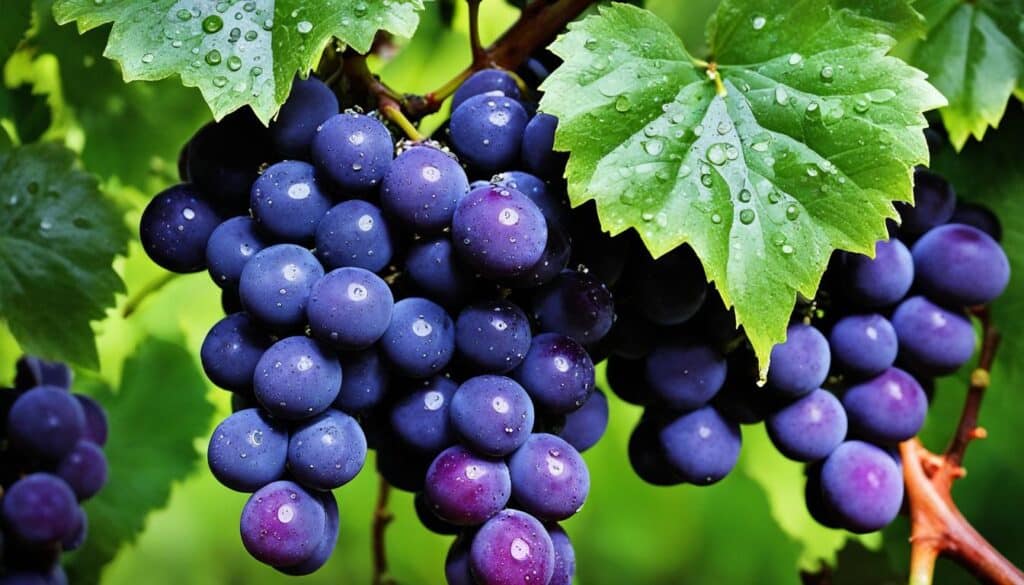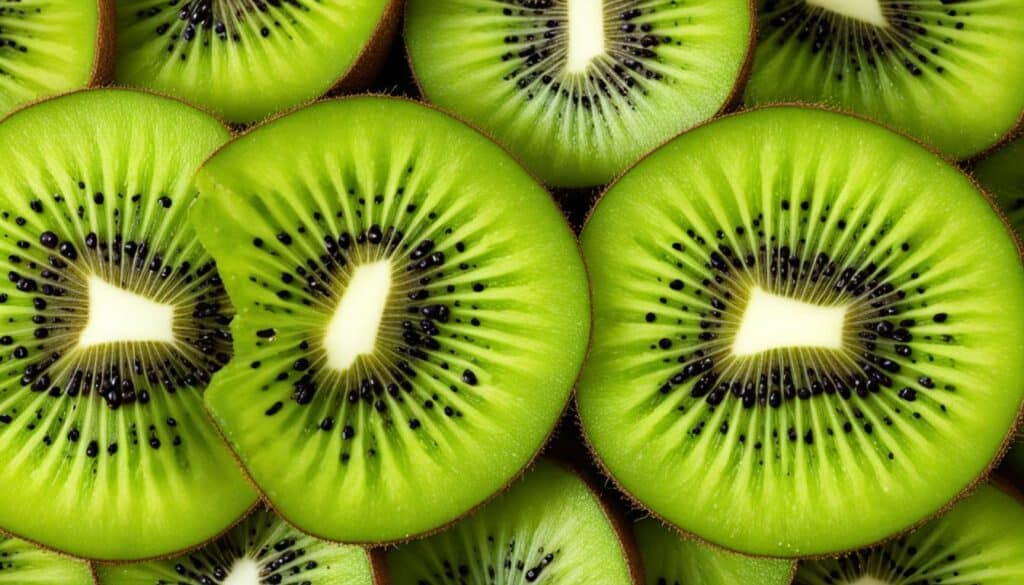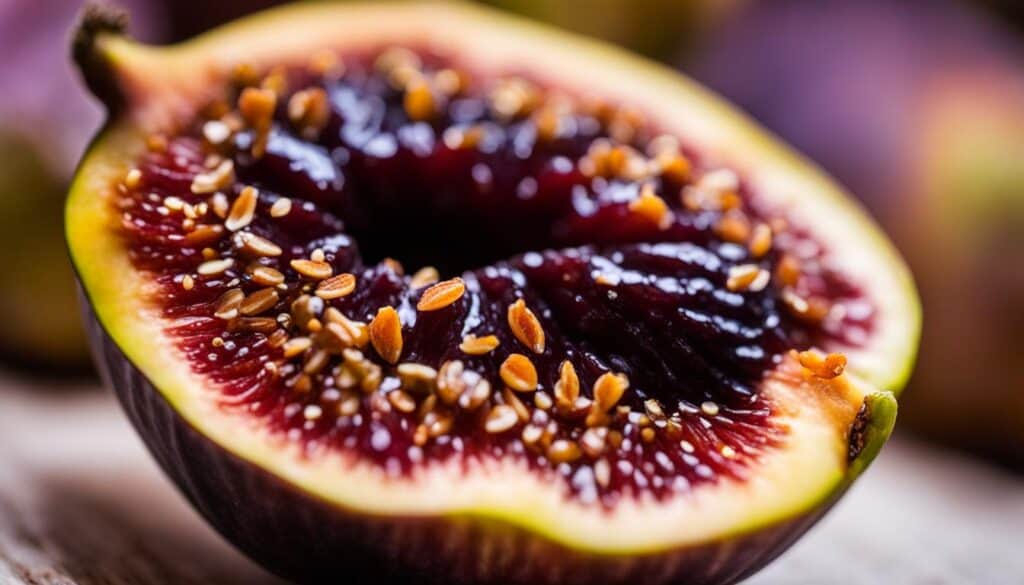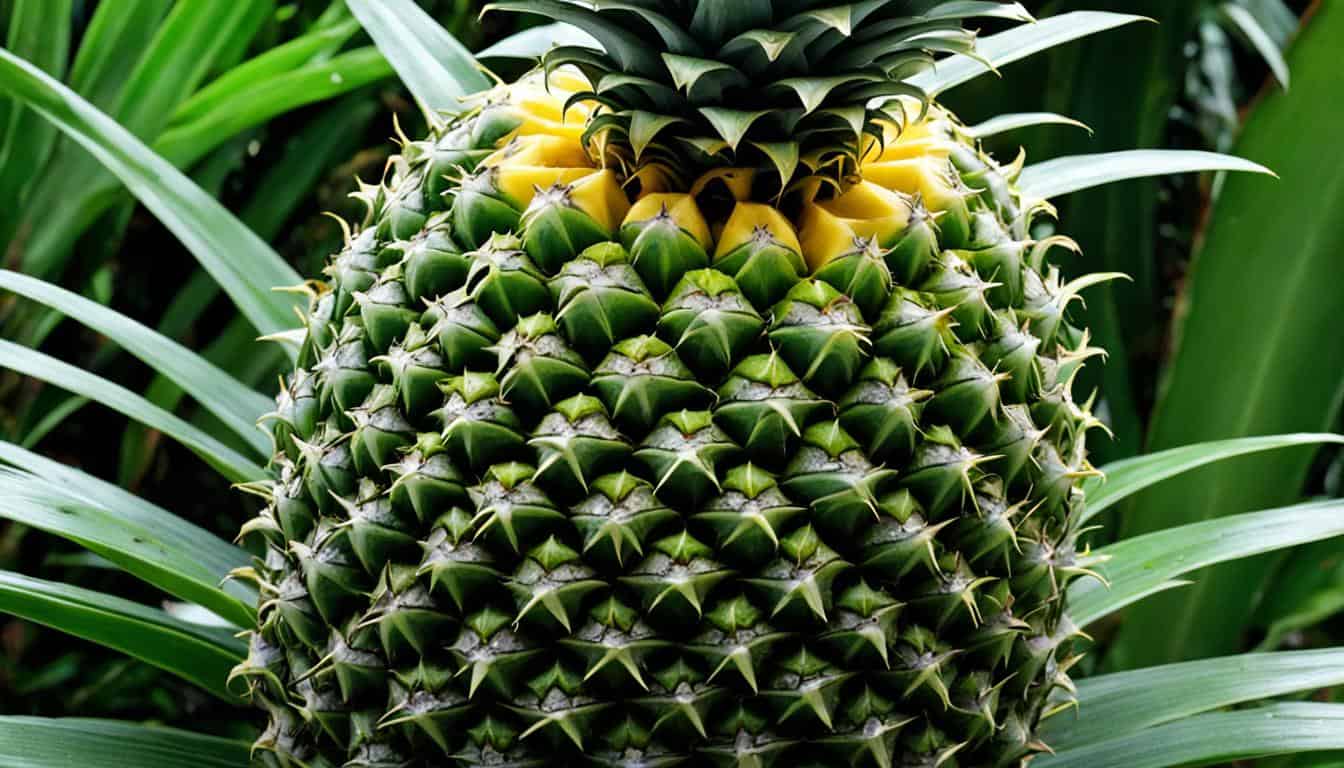Fruits are not only a great source of vitamins and minerals, but they can also be a delicious treat for the taste buds. From the tangy and tart flavors of citrus fruits to the sweet and juicy taste of berries, there is a wide range of flavors to choose from. However, some fruits stand out from the rest when it comes to their sweetness and taste. In this article, we will explore the top 10 sweetest fruits in the world, describing their flavors, nutritional benefits, and culinary uses.
Key Takeaways:
- Discover the top 10 sweetest fruits in the world.
- Learn about their flavors, nutritional benefits, and culinary uses.
- Indulge in mouth-watering sweet fruits that are naturally delicious.
- Explore the health benefits of these sweet treats.
- Find the perfect fruit with the highest sweetness for your taste buds and well-being.
Mango – The King of Sweetness
If there’s one fruit that truly deserves the title of “king of fruits,” it’s the mango. With its unparalleled sweetness and tropical flavor, mangoes reign supreme in the world of fruits. When you bite into a ripe mango, you’ll be greeted with an explosion of juicy goodness and a rich, honey-like sweetness that is simply irresistible.
The flavor profile of mangoes is a delightful blend of sweetness with hints of citrus and floral notes, transporting you to a tropical paradise with every bite. It’s no wonder why mangoes are beloved by people across the globe.
But mangoes aren’t just delicious; they are also packed with nutrition. They are a great source of antioxidants that can help protect your body against harmful free radicals. Mangoes are also rich in essential vitamins, such as vitamin C and vitamin A, which contribute to a healthy immune system, vibrant skin, and good eye health. Additionally, mangoes contain minerals like potassium, which supports proper heart function and helps maintain healthy blood pressure levels.
When it comes to culinary uses, mangoes are incredibly versatile. They can be enjoyed fresh, sliced and added to smoothies for a burst of tropical flavor, or used as a topping for salads to add a touch of sweetness. In the realm of desserts, mangoes shine bright. From mango sorbet and mango pudding to mango salsa and mango cheesecake, the possibilities are endless when it comes to incorporating mangoes into your sweet treats.
Mango Nutrition
Let’s take a closer look at the nutritional value of mangoes. Here is a breakdown of the essential nutrients found in 100 grams of ripe mango:
| Nutrient | Amount |
|---|---|
| Calories | 60 |
| Carbohydrates | 15 grams |
| Fiber | 2 grams |
| Vitamin C | 67% of the Daily Value (DV) |
| Vitamin A | 10% of the DV |
| Potassium | 6% of the DV |
These numbers demonstrate that mangoes are not only a delicious indulgence but also a nutritious choice.
Mango Culinary Uses
Here are some ways you can incorporate mangoes into your culinary creations:
- Slice mangoes and enjoy them fresh as a healthy snack.
- Add diced mangoes to your favorite fruit salad for a tropical twist.
- Blend mangoes with yogurt and ice to create a refreshing mango smoothie.
- Use pureed mangoes as a base for homemade sorbets or popsicles.
- Incorporate diced mangoes into salsas for a sweet and spicy flavor contrast.
- Top your favorite desserts, such as cakes or tarts, with fresh mango slices.
Get creative and explore the culinary possibilities that mangoes unlock. Whether you prefer them in a savory dish or as the star of a dessert, mangoes never fail to delight the taste buds with their sweet and juicy goodness.
Pineapple – A Tropical Sweet Delight
When it comes to satisfying your taste buds with a delightful burst of sweetness, look no further than the tropical fruit – pineapple. Known for its unique flavor profile, pineapple offers a sweet and tangy taste that instantly transports you to a sunny, tropical paradise.
Rich in vitamin C, manganese, and bromelain, an enzyme that aids digestion, pineapple is not just a delicious treat but also a nutritious choice. The tangy-sweet flavor of pineapple makes it a versatile fruit that can be enjoyed in various ways.
Pineapple Nutrition
Let’s explore the nutritional benefits of pineapple. Here’s a breakdown of its key nutrients:
| Nutrient | Amount per Serving (1 cup, chunks) |
|---|---|
| Calories | 82 |
| Vitamin C | 131% of the Daily Value (DV) |
| Manganese | 76% of the DV |
| Fiber | 2.3 grams |
The high vitamin C content in pineapple can boost your immune system and promote overall health. Manganese plays a vital role in metabolism and the formation of connective tissues, while fiber supports digestive health.
Pineapple Culinary Uses
“Pineapple adds a burst of tropical sweetness to both savory and sweet dishes.”
The culinary uses of pineapple are diverse and exciting. Here are some delicious ways to incorporate this tropical fruit into your meals:
- Add fresh pineapple chunks to fruit salads for a tropical twist.
- Create a refreshing pineapple salsa by combining diced pineapple with jalapenos, onions, cilantro, and lime juice. Enjoy it with grilled fish or tacos.
- Grill pineapple slices to enhance their natural sweetness and use them as a topping for burgers or as a side dish.
- Blend pineapple with coconut milk, spinach, and banana for a refreshing and nutritious smoothie.
- Bake a pineapple upside-down cake for a classic dessert with a tropical twist.
With its vibrant flavor and versatility in the kitchen, pineapple is a fruit that can truly elevate your culinary creations. So, indulge in the sweet and tangy goodness of this tropical delight and savor the taste of paradise.
Papaya – Creamy Sweetness in Every Bite
When it comes to truly indulging in the sweetness of tropical fruits, papayas are an absolute delight. With their creamy texture and unique flavor, papayas offer a delicious experience that leaves taste buds craving for more.
Unlike any other fruit, papayas have a subtle fusion of melon and citrus notes, creating a tropical symphony that tantalizes the senses. The creamy fruit is not just a treat for the taste buds but also a nutritional powerhouse. Papayas are packed with antioxidants, vitamins, and minerals like potassium, vitamin C, and vitamin A, which contribute to their impressive health benefits.
One of the standout features of papayas is their rich content of digestive enzymes. These enzymes aid in digestion, promote gut health, and reduce inflammation, making papayas a soothing option for those with digestive concerns.
Papayas can be enjoyed in various culinary forms, adding a burst of flavor to both sweet and savory dishes. They are a perfect addition to fresh fruit smoothies, lending their creamy sweetness to create a truly refreshing drink. In salads, papayas bring a unique twist, adding a tropical flair and enhancing the overall flavor profile. For those seeking more adventurous culinary experiences, papayas can even be incorporated into salsas and savory dishes for a delightful contrast.
With their irresistible taste and numerous health benefits, papayas are truly a gift of nature. So why not treat yourself to the creamy sweetness of papayas and savor the tropical indulgence in every bite?

Grapes – Nature’s Bite-sized Sweetness
Grapes are small fruits bursting with sweet and juicy flavors. They come in various colors, such as red, green, and purple, and offer a delightful balance of sweetness and tartness. Grapes are a good source of vitamin C and potassium, and they also contain antioxidants like resveratrol, which can have heart-protective benefits. Grapes are perfect for snacking, but they can also be used in juices, wines, jams, or even roasted for a unique flavor.

When it comes to grape varieties, there are numerous options to choose from. Each variety has its own distinct flavor profile and culinary uses. Here are some popular grape varieties:
| Grape Variety | Flavor | Color |
|---|---|---|
| Red Globe | Sweet and slightly tangy | Red |
| Thompson Seedless | Very sweet and mildly tangy | Green |
| Concord | Intensely sweet and tart | Purple |
| Green Seedless | Mildly sweet | Green |
These are just a few examples, and there are many more grape varieties out there, each with its own unique characteristics. Whether you prefer a sweet and tangy variety or a milder sweetness, there is a grape to suit every palate.
In addition to their delicious taste, grapes also offer a range of nutritional benefits. Here is a breakdown of the nutritional content in 1 cup (about 151 grams) of grapes:
- Calories: 104
- Carbohydrates: 27.3 grams
- Fiber: 1.4 grams
- Protein: 1.1 grams
- Fat: 0.2 grams
- Vitamin C: 14% of the Daily Value (DV)
- Potassium: 6% of the DV
This nutrient-packed fruit also contains other vitamins, minerals, and antioxidants that contribute to overall health and well-being.
When it comes to culinary uses, grapes are incredibly versatile. Aside from being enjoyed as a simple snack, they can be incorporated into various dishes and preparations. Here are some popular uses for grapes:
- Adding grapes to fruit salads for a burst of sweetness.
- Using grapes in juices and smoothies for natural sweetness and flavor.
- Making wines and sparkling beverages from grape varietals.
- Creating jams, jellies, and preserves with grapes for a sweet spread.
- Roasting grapes and serving them as a unique and flavorful side dish.
The culinary possibilities with grapes are endless, and their natural sweetness can elevate various dishes.
Watermelon – A Refreshing Sweet Summer Treat
When it comes to beating the summer heat, there’s nothing quite like a juicy slice of watermelon. This thirst-quenching fruit is not only delicious but also packed with nutrients that will keep you feeling refreshed and revitalized.
The Perfect thirst-quenching Fruit
Watermelon is made up of about 90% water, making it the perfect hydrating snack for hot summer days. Its high water content, combined with its sweet and juicy flavor, makes it a refreshing treat that can help quench your thirst and keep you cool.
Nutritional Benefits of Watermelon
Watermelon is a nutritional powerhouse, packed with essential vitamins and minerals. It is a great source of vitamin C, which boosts the immune system and promotes healthy skin. It also contains vitamin A, which is important for eye health, and potassium, which helps maintain proper heart function.
But perhaps one of the most notable nutrients found in watermelon is lycopene. Lycopene is an antioxidant that gives watermelon its vibrant red color and has been linked to a reduced risk of certain cancers.
Culinary Uses of Watermelon
The versatility of watermelon goes beyond just enjoying it on its own. It can also be used in a variety of culinary creations. From refreshing fruit salads to flavorful smoothies and thirst-quenching sorbets, the possibilities are endless.
For a unique twist, try grilling watermelon slices to bring out their natural sweetness and add a smoky flavor. Watermelon can also be incorporated into savory dishes, such as salsa, to provide a hint of sweetness and balance out spicy flavors.
No matter how you choose to enjoy it, watermelon is sure to delight your taste buds and keep you feeling refreshed during the summer months.
| Watermelon Nutrition Facts | |
|---|---|
| Vitamin C | 20% of the Daily Value (DV) |
| Vitamin A | 17% of the DV |
| Potassium | 5% of the DV |
| Lycopene | 6,900 micrograms per 100 grams |
Strawberry – Bursting Sweetness in Every Bite
Strawberries are small but mighty fruits known for their burst of sweetness and tartness. With their vibrant red color and juicy texture, they are a treat for both the eyes and the taste buds. The naturally sweet flavor of strawberries is enhanced by a subtle tartness that adds a delightful twist.
Not only are strawberries delicious, but they are also packed with nutrition. They are an excellent source of vitamin C, which supports the immune system and promotes collagen production for healthy skin. Strawberries also contain manganese, a mineral that plays a vital role in metabolism and bone health.
Additionally, strawberries are rich in antioxidants called anthocyanins, which give them their bright color. These antioxidants have been linked to numerous health benefits, including reducing inflammation, protecting against cancer, and improving heart health.
Strawberries are incredibly versatile in the culinary world. They can be enjoyed fresh as a standalone snack or incorporated into various dishes. Here are some popular culinary uses for strawberries:
- Desserts: Strawberries are a classic addition to desserts like cakes, pies, tarts, and ice cream sundaes.
- Jams and sauces: They can be cooked down into flavorful jams and sauces that can be slathered on toast or used as toppings for pancakes and waffles.
- Salads: The sweetness of strawberries pairs well with greens in salads, adding a burst of flavor and a touch of natural sweetness.
In summary, strawberries are a versatile fruit that combines sweetness and tartness in every bite. Rich in vitamin C, manganese, and antioxidants, strawberries offer both delicious flavor and potential health benefits. Whether enjoyed fresh, in desserts, or added to salads, strawberries are sure to satisfy your craving for something sweet.

Kiwi – Tangy and Sweet Delight
Among the tropical fruits, kiwi stands out with its unique combination of tanginess and sweetness. Not only does it have a refreshing taste, but it also offers a plethora of nutritional benefits.
Kiwi is packed with vitamin C, which boosts the immune system and promotes collagen production for healthy skin. It is also rich in vitamin K, which plays a crucial role in blood clotting and bone health. Additionally, kiwi contains potassium, an essential mineral that helps regulate blood pressure.
But that’s not all! Kiwi is loaded with antioxidants like lutein and zeaxanthin, which promote eye health and protect against age-related macular degeneration. These antioxidants, along with the high vitamin C content, help fight against free radicals and reduce the risk of chronic diseases.
The culinary uses of kiwi are as varied as its nutritional benefits. The tangy and sweet flavor of kiwi adds a refreshing twist to fruit salads and smoothies. It can also be used to create delectable desserts, such as kiwi tarts or kiwi sorbets. The vibrant green color and unique taste of kiwi make it an attractive ingredient in many culinary creations.
So whether you enjoy kiwi on its own or incorporate it into various dishes, you can savor the tangy and sweet delight that this tropical fruit has to offer.
Culinary Uses of Kiwi:
- Add sliced kiwi to fruit salads for a burst of tangy sweetness.
- Blend kiwi with other fruits to create refreshing smoothies.
- Use kiwi as a topping for yogurt, ice cream, or pancakes.
- Create unique desserts, such as kiwi tarts, kiwi pavlovas, or kiwi sorbets.
- Incorporate kiwi into savory dishes, such as kiwi salsa for grilled meats or kiwi-infused dressings for salads.
“The tangy and sweet flavor of kiwi adds a refreshing twist to any culinary creation.”
| Nutrient | Amount per 100g |
|---|---|
| Calories | 61 |
| Carbohydrates | 15g |
| Fiber | 3g |
| Protein | 1.1g |
| Fat | 0.5g |
| Vitamin C | 92.7mg |
| Vitamin K | 41.0mcg |
| Potassium | 312mg |

<!—->
Fig – Honey-like Sweetness and Chewy Texture
Figs are a unique fruit with a delightful combination of honey-like sweetness and a soft, chewy texture. These sweet and chewy delights offer a rich and complex flavor profile that is truly irresistible.
Figs are not only delicious, but they also provide several nutritional benefits. They are a good source of dietary fiber, which helps support digestive health and promote feelings of fullness. Figs are also rich in potassium, which is essential for maintaining proper heart function and regulating blood pressure. Additionally, figs contain antioxidants that help protect the body’s cells from damage caused by harmful free radicals.

There are several varieties of figs, each with its own unique flavor and texture. Common fig varieties include Black Mission, Brown Turkey, and Kadota. These varieties differ in color, sweetness, and overall flavor, providing plenty of options to suit various taste preferences.
When it comes to culinary uses, figs can be enjoyed in various ways. They can be enjoyed fresh as a healthy snack or added to salads for a touch of natural sweetness. Dried figs are a popular choice for baking and can be used in cakes, cookies, and bread. They also pair well with cheese and make a delicious addition to charcuterie boards and appetizer platters.
Incorporating figs into your diet is a great way to satisfy your sweet tooth while enjoying the many health benefits they offer. So why not indulge in the sweet and chewy goodness of figs and enhance your culinary creations with their unique flavor and texture?
Peach – Velvety Sweetness and Fragrance
Peaches are renowned for their velvety texture, succulent juiciness, and sweet floral flavor. They offer a delightful combination of sweetness and acidity that is truly irresistible. Peaches are a good source of vitamins A and C, and they also contain dietary fiber and antioxidants. They can be enjoyed fresh, used in pies, cobblers, or jams, or even grilled for added flavor. The juicy sweetness and fragrance of peaches make them a beloved fruit among many.
Peach Varieties
Peaches come in a variety of cultivars and each has its own unique flavor characteristics. Some popular peach varieties include:
- Freestone Peaches: These peaches have flesh that easily separates from the pit, making them ideal for eating fresh.
- White Peaches: Known for their pale-colored flesh and delicate, sweet flavor.
- Yellow Peaches: These peaches have a typical peachy flavor and are widely available.
- Clingstone Peaches: The flesh of clingstone peaches firmly clings to the pit, making them better suited for cooking and preserves.
Peach Nutrition
Peaches are not only delicious but also offer several health benefits. Here are some key nutritional highlights:
| Nutrient | Amount per 100g |
|---|---|
| Calories | 39 |
| Protein | 0.9g |
| Fat | 0.3g |
| Carbohydrates | 9.5g |
| Dietary Fiber | 1.5g |
| Vitamin C | 6.6mg |
| Vitamin A | 326 IU |
| Potassium | 190mg |
Peach Culinary Uses
Peaches are incredibly versatile and can be used in a variety of culinary creations. Here are some popular ways to enjoy peaches:
- Fresh: Enjoy a juicy, ripe peach on its own as a refreshing snack.
- Pies and Cobblers: Bake peach pies or cobblers for a delicious dessert.
- Jams and Preserves: Use peaches to make homemade jams, preserves, or fruit spreads.
- Grilled: Grill peach halves for a caramelized and smoky flavor.
- Salads: Add sliced peaches to salads for a burst of sweetness.
- Smoothies: Blend peaches into smoothies for a naturally sweet and creamy texture.
Conclusion
In conclusion, the world is filled with a variety of sweet fruits that offer unique flavors, culinary versatility, and numerous health benefits. From the tropical sweetness of mangoes and pineapples to the creamy sweetness of papayas and figs, each fruit on the list has its own distinct qualities and can satisfy any sweet tooth.
These sweetest fruits are not only delicious but also packed with essential vitamins, minerals, antioxidants, and dietary fiber, contributing to overall well-being and helping prevent chronic diseases. Indulging in the natural sweetness of these fruits can be a guilt-free indulgence in sweetness.
So go ahead and indulge in the sweetness of nature’s bounty while reaping the nutritional rewards. Add these top sweetest fruits to your diet and enjoy the mouth-watering flavors and health benefits they offer!
FAQ
What is the sweetest fruit in the world?
Mango is often considered the sweetest fruit in the world.
What are some naturally sweet fruits?
Some naturally sweet fruits include pineapples, papayas, grapes, watermelons, strawberries, kiwis, figs, and peaches.
What are the health benefits of sweet fruits?
Sweet fruits are not only delicious but also packed with essential vitamins, minerals, antioxidants, and dietary fiber, contributing to overall well-being and helping to prevent chronic diseases.
How can mangoes be used in culinary creations?
Mangoes can be enjoyed fresh, added to smoothies, used in salads, or incorporated into various desserts and sauces.
What are the culinary uses of pineapples?
Pineapples can be enjoyed fresh, used in fruit salads, incorporated into desserts, or even grilled for a unique flavor.
How can papayas be incorporated into dishes?
Papayas can be enjoyed fresh, added to smoothies, used in salads, or incorporated into savory dishes and salsas.
What are the different grape varieties?
Grapes come in various colors, such as red, green, and purple, each offering a delightful balance of sweetness and tartness.
How can watermelons be used in culinary creations?
Watermelons can be enjoyed on their own or used in fruit salads, smoothies, sorbets, grilled for a unique flavor, or incorporated into various dishes.
What are the culinary uses of strawberries?
Strawberries can be enjoyed fresh, used in desserts, made into jams or sauces, or added to salads for a burst of sweetness.
How can kiwis be used in culinary creations?
Kiwis can be enjoyed on their own, added to fruit salads, used in smoothies, or incorporated into various desserts.
How can figs be incorporated into dishes?
Figs can be enjoyed fresh, dried, or incorporated into various dishes like salads, desserts, or charcuterie boards.
What are the culinary uses of peaches?
Peaches can be enjoyed fresh, used in pies, cobblers, or jams, or even grilled for added flavor.





Leave a Reply